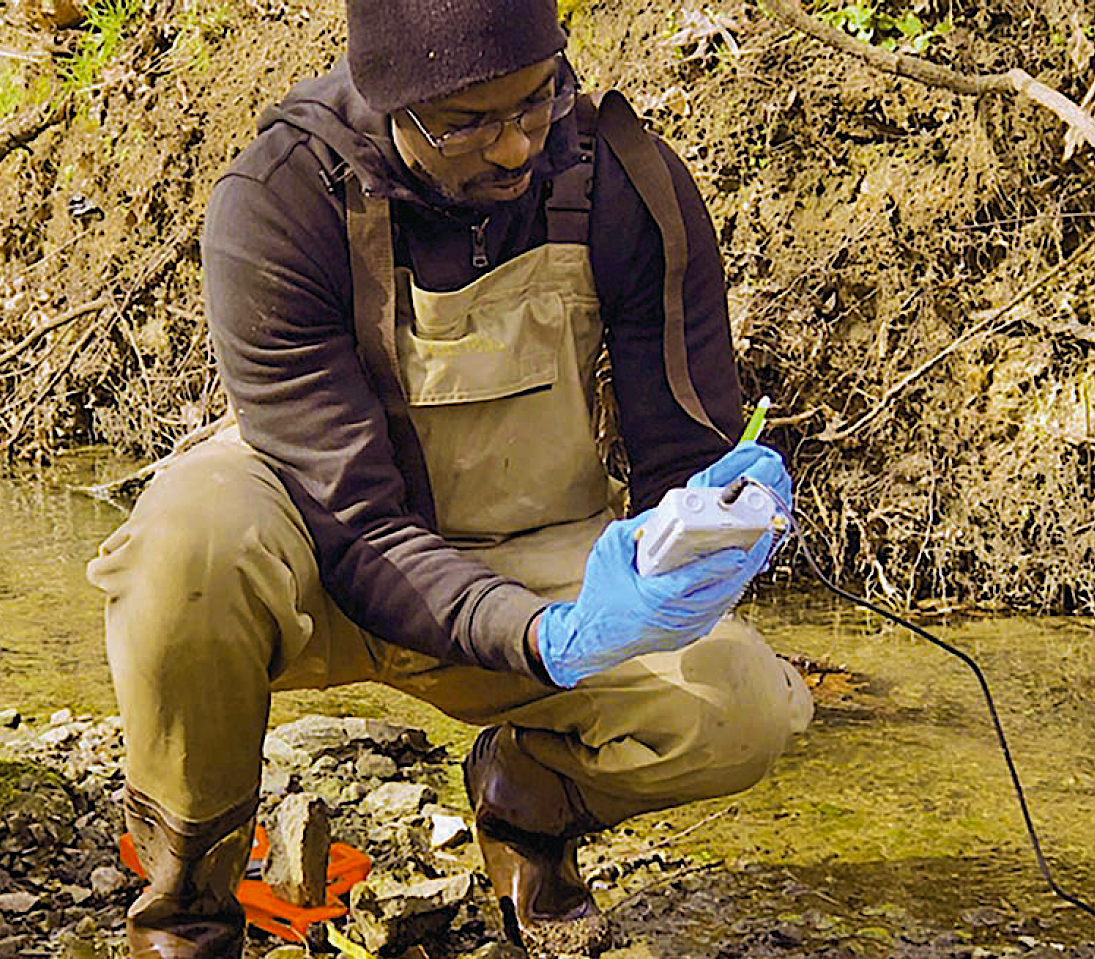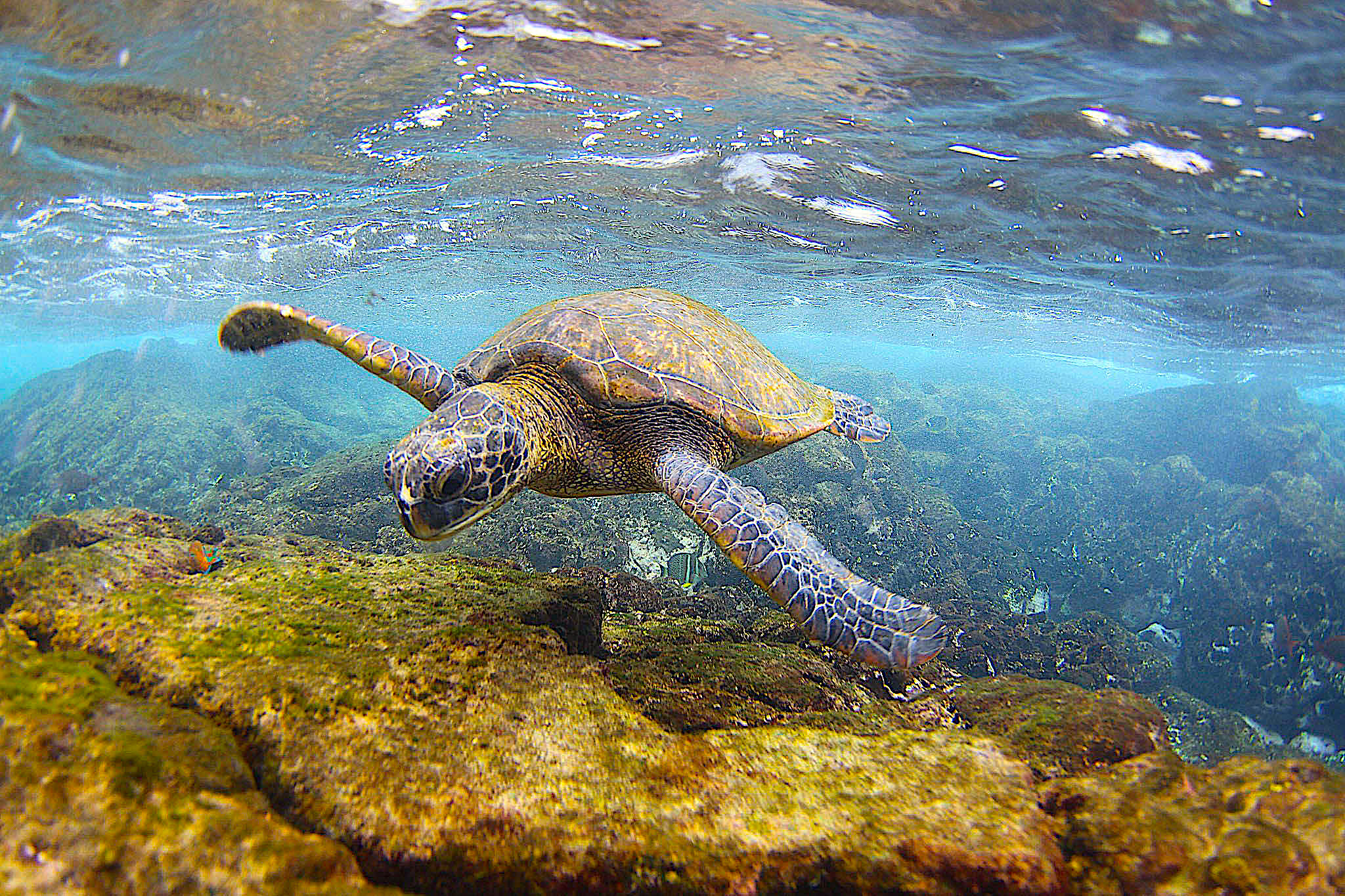Blood Draw at the Horseshoe Corral
An essential medical safety test used around the world depends on horseshoe crab blood, and scientists may have discovered the key to a sustainable supply.
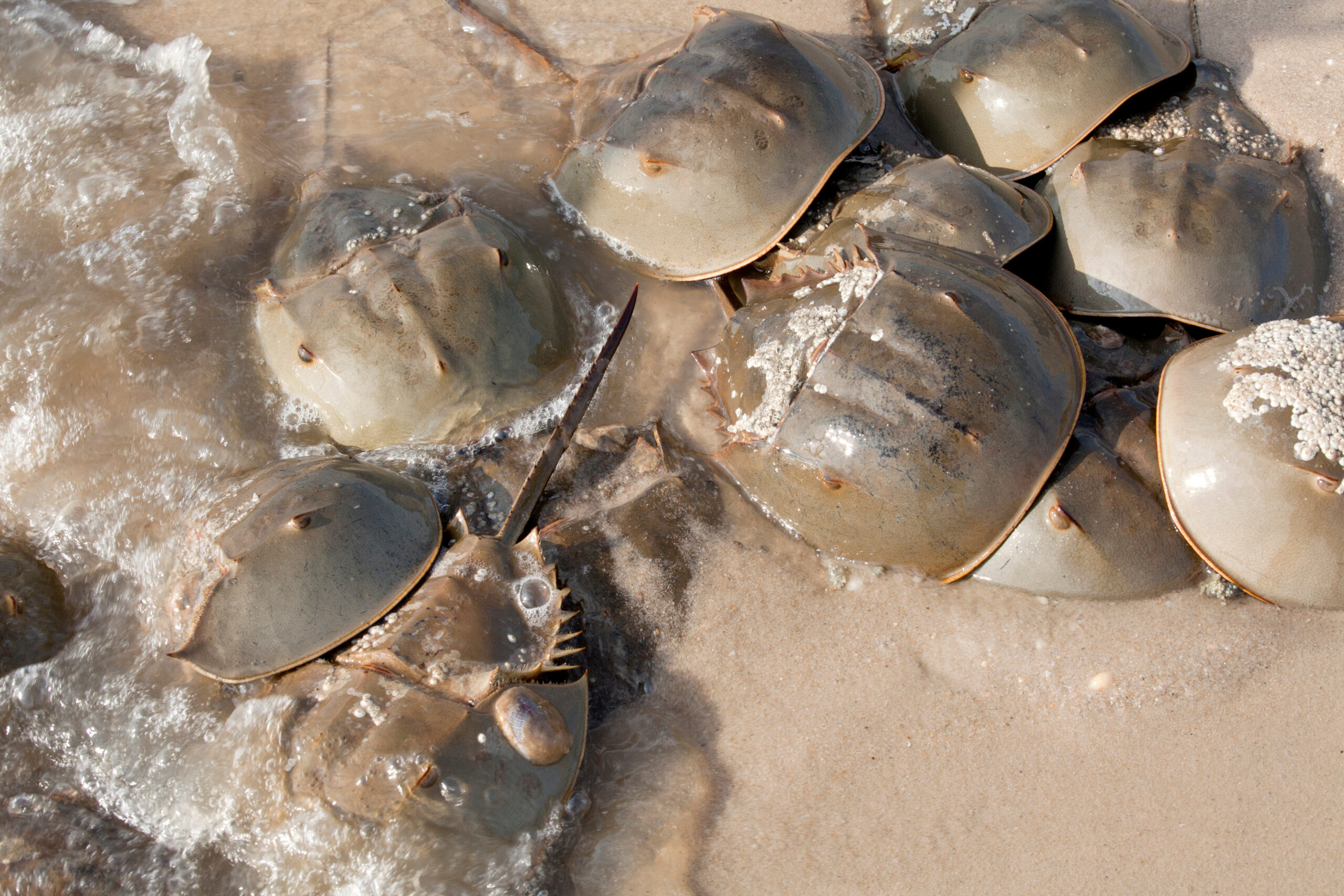
Once researchers develop a COVID-19 vaccine that receives approval from the U.S. Food and Drug Administration, we undoubtedly will celebrate the news. Those scientists will deserve our gratitude. But we might also appreciate another important player: the American horseshoe crab (Limulus polyphemus), a rugged coastal creature found along the eastern seaboard and portions of the Gulf of Mexico.
Horseshoe crab blood is the basis for a gold-standard safety test used worldwide on vaccines and other injectable medicines, intravenous fluids, and implantable medical devices. Specifically, the test, or assay, identifies whether certain bacterial contaminants called endotoxins are present, and to what extent. Endotoxins can be detrimental to human health if they appear in high concentrations in the blood.
In essence, the assay consists of a series of enzymes from the horseshoe crab’s only blood cell, the amebocyte. Known as LAL, for Limulus amebocyte lysate, the extract reacts when it comes into contact with endotoxins, forming a telltale clot.

In 2019, the researchers who developed the LAL assay — Jack Levin and Frederik Bang — won a Golden Goose Award, which honors seemingly obscure research that ultimately has a significant impact on society.
“The ability to measure in a precise way the amount of endotoxin in things we are exposed to every day has a societal benefit that I think few people recognize,” said Brad Fenwick, a senior vice president at the science- focused publisher Elsevier, in a video published by the Golden Goose Awards.
Presently, there are four U.S.-based LAL manufacturers, three of which serve the U.S. market. Horseshoe crabs are gathered from Atlantic waters up and down the East Coast and transported to facilities for blood collection, then returned to the location they came from.
Those companies have stated that they’re committed to horseshoe crab welfare and conservation. “Overall it’s a sustainable industry if it’s done properly,” says Jennifer Mattei, a biologist who studies horseshoe crabs at Sacred Heart University in Connecticut.
Still, the reliance on wild organisms — whose numbers have ranged from plentiful to precarious — has led researchers to pursue alternative strategies for endotoxin testing.
One company in particular is taking a page out of the oyster grower’s book: Greensboro-based Kepley Biosystems Inc., which received initial funding from North Carolina Sea Grant, aspires to build a network of horseshoe crab aquaculture facilities for the express purpose of blood collection.
“There was an opportunity to benefit a species both critical to the ecosystem and to human health,” says Kepley Biosystems Inc. founder and president Anthony Dellinger. “This aligns with our company philosophy to focus on projects that provide a net good to the public and the planet while addressing massive global markets.”
Ancient Mariners
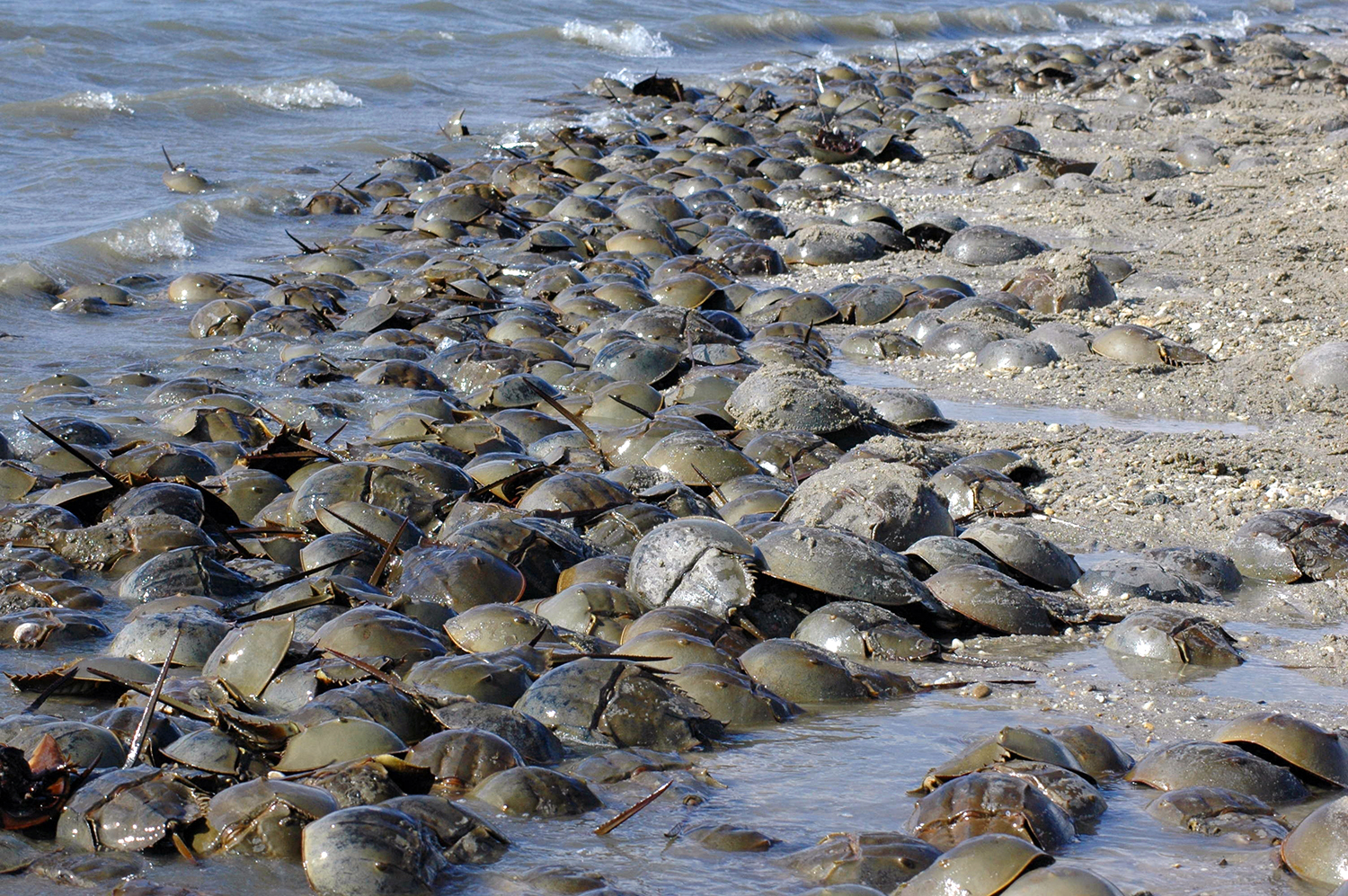
Despite what their name suggests, horseshoe crabs aren’t actually crabs. More closely related to spiders and scorpions, they hail from an ancient lineage predating the oldest dinosaurs by a couple hundred millennia. Based on fossil evidence, horseshoe crab physique has remained relatively unchanged for nearly 450 million years.
“They’re amazing to look at, because they have a very unique body plan that we don’t see in other organisms,” says Mattei, who runs a horseshoe crab tracking program called Project Limulus.
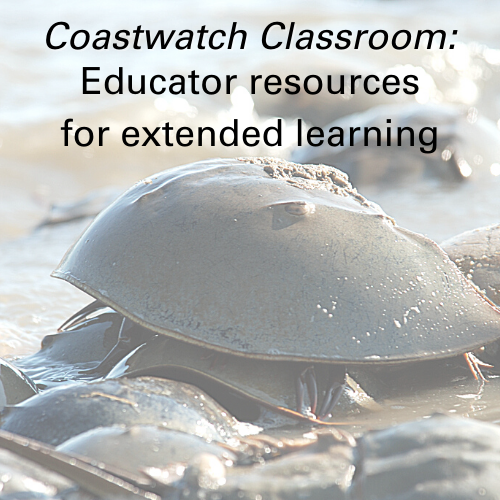
The creature’s tank-like structure consists of a front shell hinged to a back shell, where a pointy tail called a telson pokes out. Despite its menacing appearance, “it’s not a weapon,” says North Carolina Sea Grant marine education specialist Terri Kirby Hathaway. “If the animal gets turned upside down, it uses that tail to push into the sand and turn itself back over.” The telson also functions as a rudder in the water and has patches of specialized cells that detect light.
A glance under the carapace reveals six pairs of appendages for locomotion and foraging and so-called book gills — thin sheets of tissue with a leathery cover — used for breathing and propulsion.
American horseshoe crabs are coastal species from Maine to northeast Gulf of Mexico states, as well as along Mexico’s Yucatán Peninsula. While the animals have different habitat requirements at different stages of their life cycle, spawning adults depend on sandy beaches where they come ashore annually, typically during spring high tides. Females dig pits in the sand where they deposit tens of thousands of eggs, which males then fertilize.
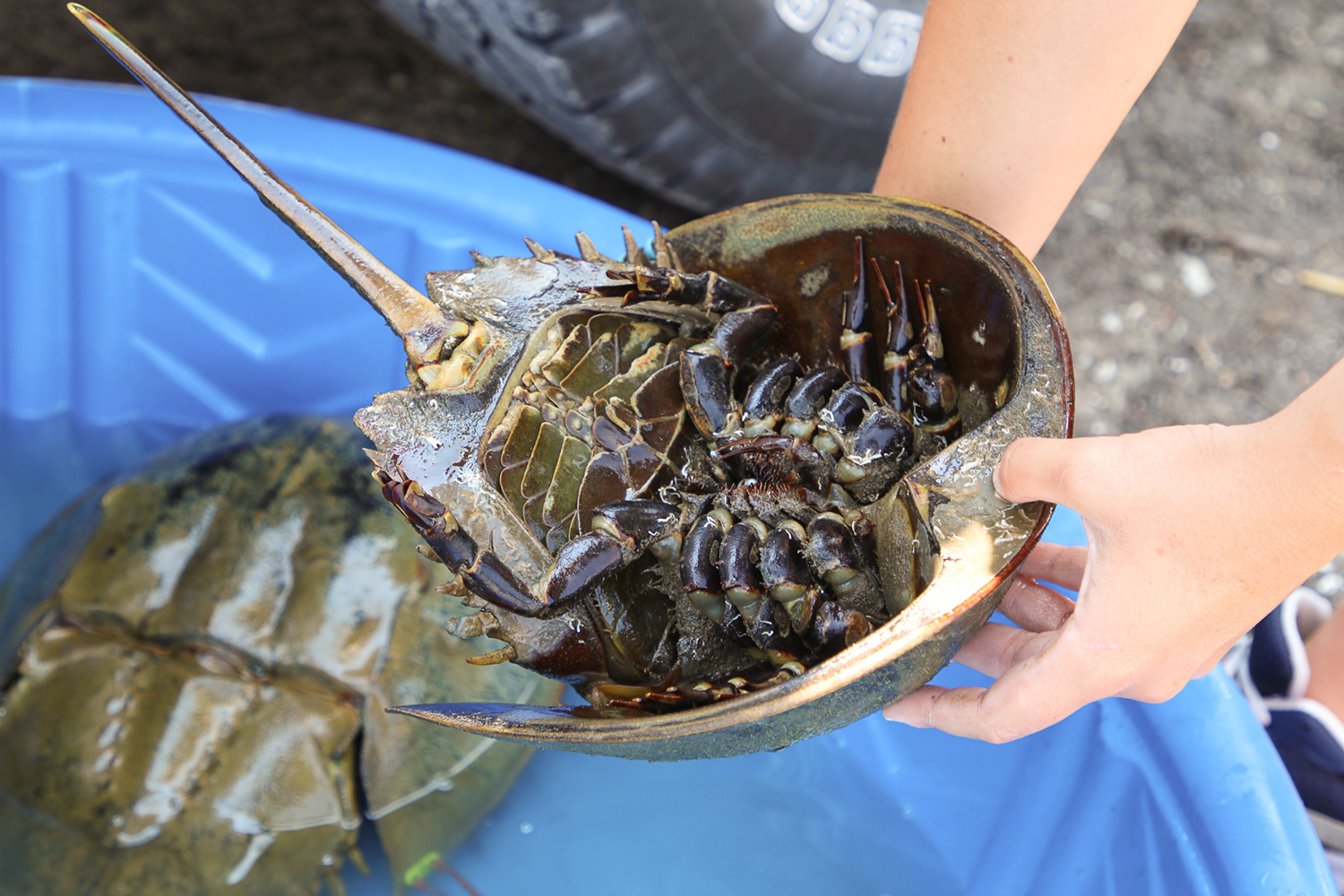
It takes 10 years for a horseshoe crab to mature to an adult, which can reach at least 20 years of age, according to Mattei. These long-lived arthropods are integral to their ecosystems. For starters, loggerhead turtles eat them, and a host of organisms such as barnacles, marine snails called slipper shells, and anemones reside on horseshoe crab shells.
Their eggs, meanwhile, nourish various invertebrates, finfish, and migrating shorebirds. For example, during a 9,000-mile migration from the tip of South America to the Canadian Arctic, Atlantic Coast red knots touch down on eastern beaches to refuel. It’s no coincidence that Delaware Bay, the second-largest staging area for migrating shorebirds in North America, is also a horseshoe crab spawning hotspot.
“There’re some organisms that are really important when they’re abundant, and the horseshoe crab is one of them,” Mattei says.
Luck of the Draw
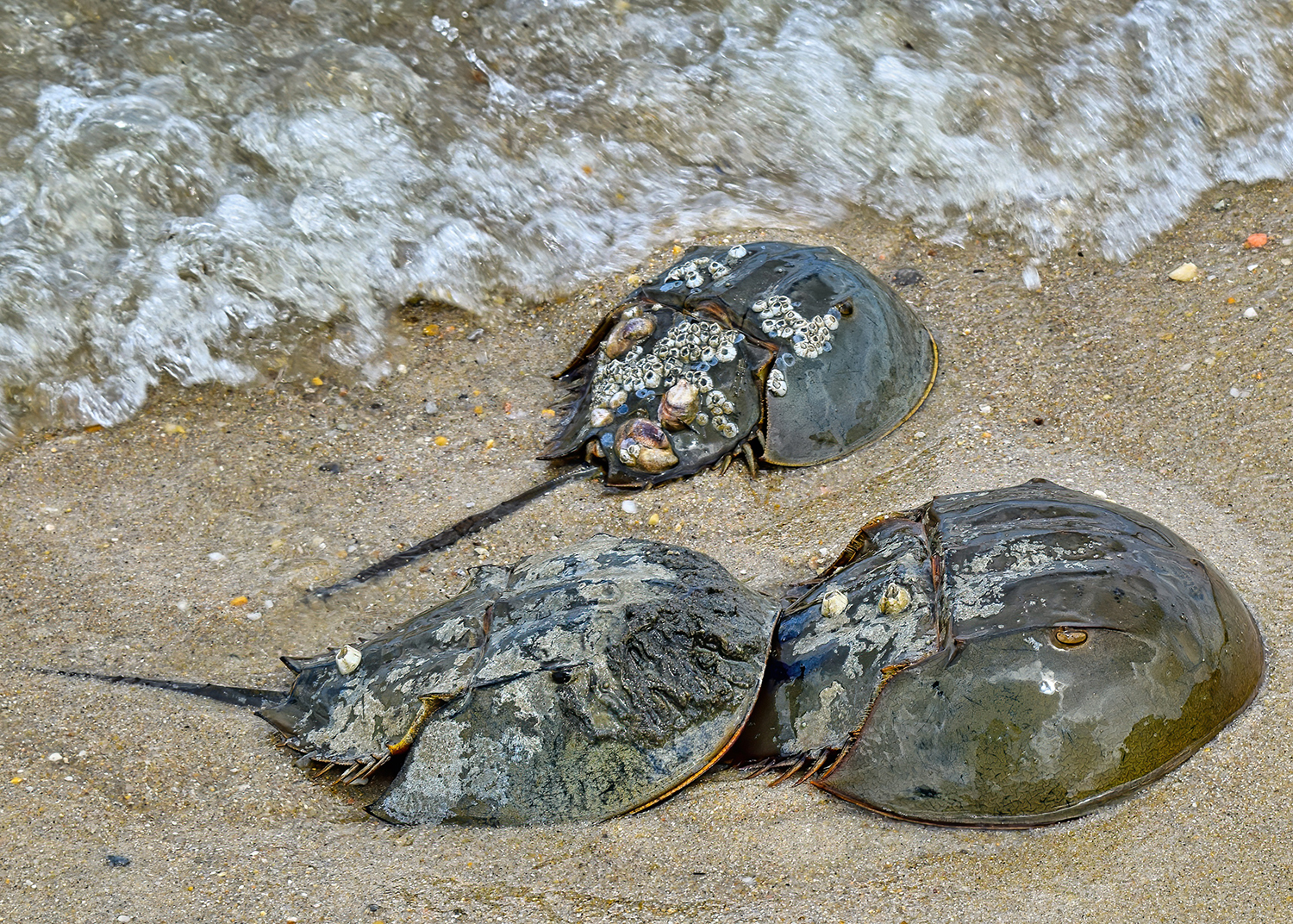
Never in his life had Jack Levin seen a horseshoe crab when he arrived at the Marine Biological Laboratory in Woods Hole, Massachusetts, during the summer of 1963 to study the organism’s blood.
At the time, Levin was a research fellow in hematology at the Johns Hopkins University (JHU) School of Medicine and Hospital, where he was studying blood clotting in rabbits. Levin’s advisor had suggested he collaborate with a JHU colleague named Frederik Bang, who spent summers at Woods Hole. Bang was “a pioneer in applying marine biology to medical research,” the New York Times noted after his death in 1981.
Bang had done earlier research on horseshoe crab blood clotting. Levin was to continue in that vein, conducting basic research into similarities between the horseshoe crab’s blood cell — the amebocyte — and human platelets, which help blood clot.
Bang acquainted Levin with his study subject by pointing to a tank containing horseshoe crabs and instructing him to, “‘Pick one out,’” recalls Levin, now on the faculty at the University of California School of Medicine, San Francisco. “Of course, I was absolutely thunderstruck, sure that my fingers would either be crushed by one of their claws or stuck by their tail.” (Neither happened.)
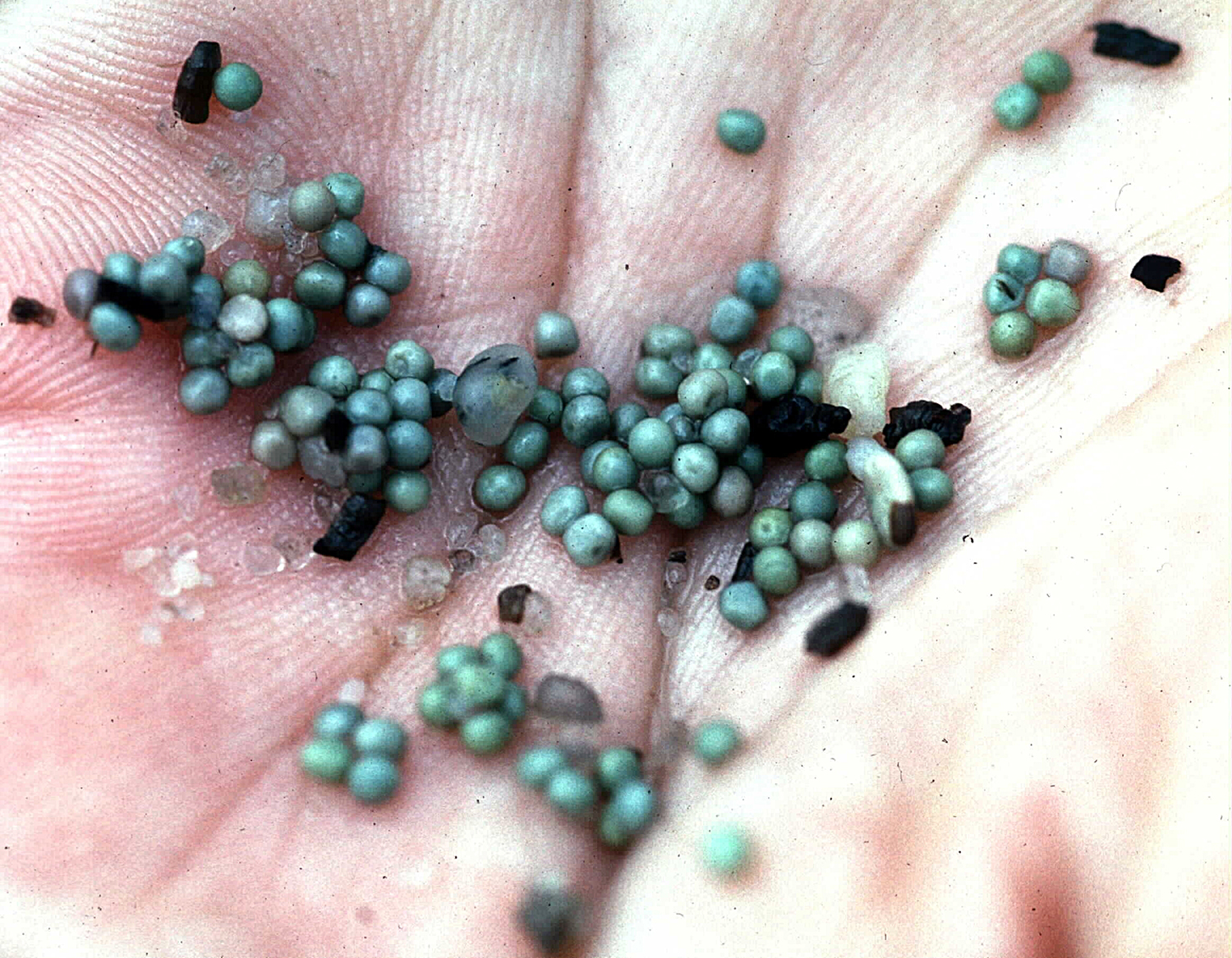
As Levin pursued his research, he noticed that samples of liquid horseshoe crab blood left in the lab overnight had coagulated by the next morning, despite the addition of standard anticoagulants. He wondered: Could his glassware be contaminated? From his studies at JHU, he knew that bacterial endotoxins caused rabbit blood to clot. Maybe endotoxins were responsible for horseshoe crab blood clotting as well.
Further experiments supported Levin’s hunch — endotoxins prompted blood coagulation. He also learned that clotting was the result of an enzymatic reaction. Once a clot forms, the amebocyte unleashes other factors that work to destroy the source of infection, Levin explains.
The adaptation is phenomenal if you consider the horseshoe crab’s habitat, he says. “An animal like Limulus is crawling around the bottom, getting bumped, damaged, and they have to have a mechanism that immediately controls bacterial infection,” Levin says. “The amebocyte is an all-purpose cell. It aggregates, traps the bacteria, produces clots around them, and then is capable of releasing substances that will kill or immobilize the bacteria. It’s a much more effective all-purpose cell than anything we humans have.”
Levin went on to develop a way to extract the clotting factors from the amebocyte. In 1987, the LAL assay became the standard method of screening for bacterial endotoxins. Until that point, a test that required the use of live rabbits had been used.
“Not only was the Limulus test more sensitive, but it was relatively easy to do,” as well as practical, Levin says. Overall, “it was clearly enormously better.”
Out of the Wild
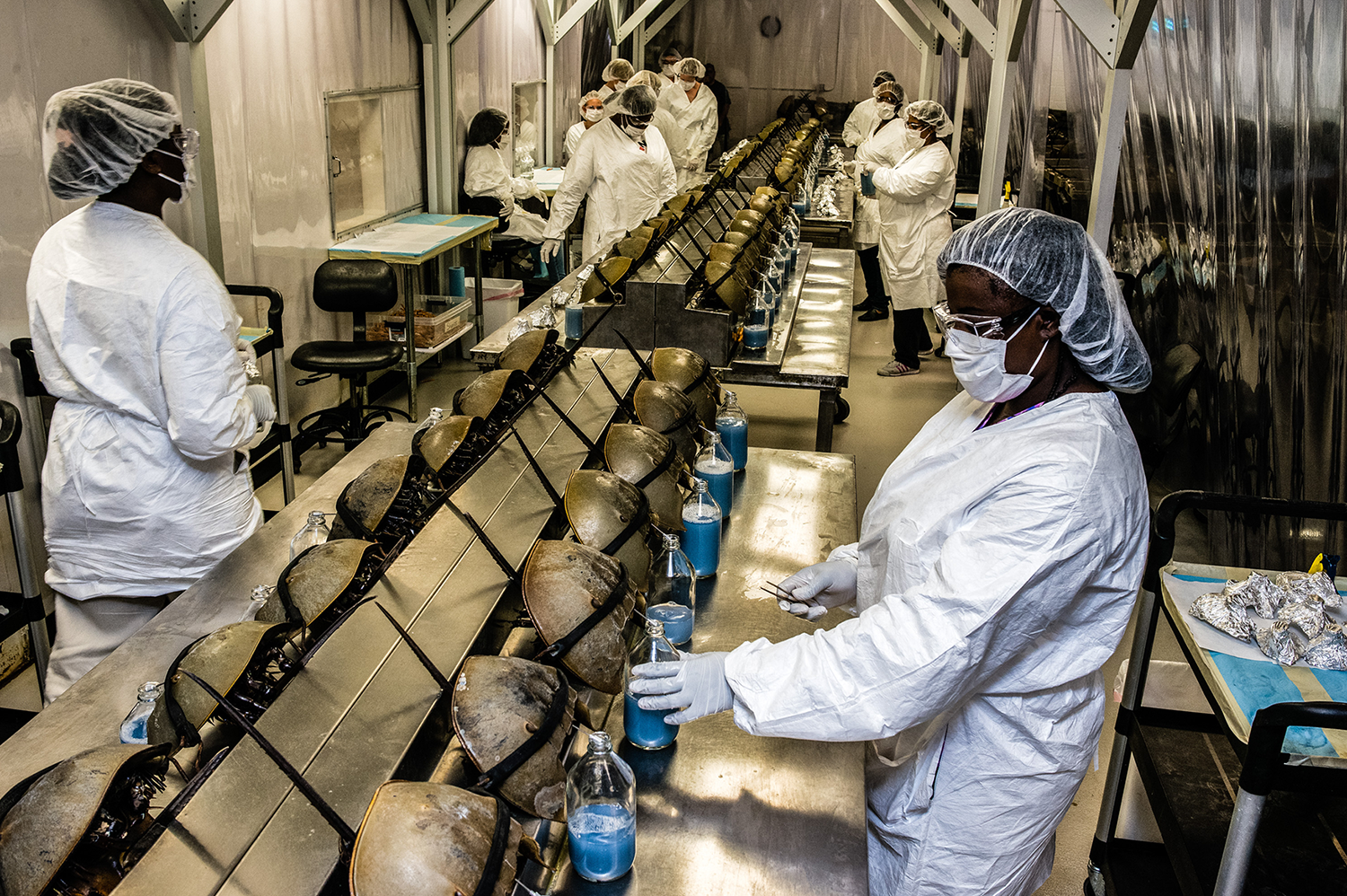
The collection of horseshoe crabs for the biomedical industry ranks second to their commercial use as bait in the eel and whelk fisheries, according to the Atlantic States Marine Fisheries Commission, or ASMFC, which oversees the management of horseshoe crabs from Maine south through Florida’s East Coast.
The ASMFC assumed that role in 1998, following several years of dramatic growth in horseshoe crab bait landings. Since then, landings have declined and become fairly stable. In 2018, close to 660,000 horseshoe crabs were harvested for use as bait. Whereas 100% of bait crabs die, the ASMFC estimates a 15% mortality rate from bleeding the animals for LAL production.
Although the collection of horseshoe crabs for biomedical purposes has increased since reporting began in 2004, the number has remained relatively consistent over the past several years, hovering around 500,000.
Yet, these pandemic times beg the question: Will COVID-19 vaccine production have a measurable impact on the demand for horseshoe crab blood?
“It was estimated that the production of 5 billion doses of vaccine will require less than a day’s production from three U.S.-based LAL manufacturers,” according to Allen Burgenson, who chairs the ASFMC’s horseshoe crab advisory panel and works for Lonza Walkersville Inc., which produces LAL in Maryland.
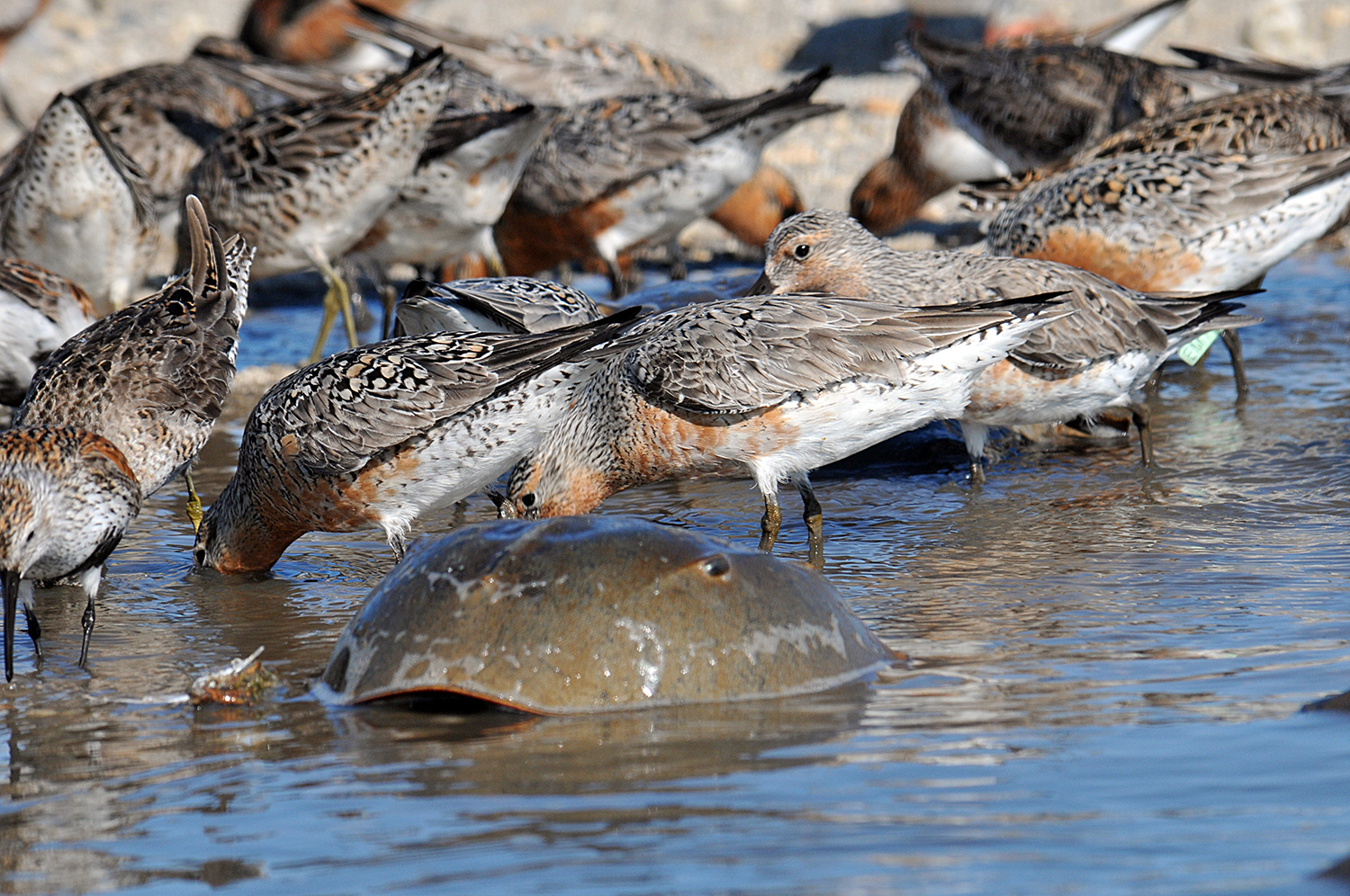
Even so, the global bacterial endotoxin testing market is expected to double by 2024 based on growth in the pharmaceutical, medical device, and healthcare facility industries, says Glenn Gauvry, founder and president of the Ecological Research & Development Group Inc., a nonprofit horseshoe crab conservation organization.
The American horseshoe crab population as a whole appears to be generally stable, according to the ASMFC, aside from the New York region, where it’s declining. In North Carolina, the population also looks healthy. “It does seem like, over time, it has been increasing” in the state based on the available data, says Kristen Anstead, a stock assessment scientist with the ASMFC.
In Asia, however, the future is bleaker. There, a version of the assay is made with blood from the two horseshoe crab species of the genus Tachypleus. One of those species has been listed as endangered by the International Union for Conservation of Nature, or IUCN. There is insufficient data on the other to determine its conservation status.
If it turns out that Gauvry is right and demand for bacterial endotoxin testing spikes in coming years, the industry might have to lean more heavily on American horseshoe crabs. “Whether Limulus can handle that is in question,” Gauvry says. “Right now, it seems that it can, but it’s something that we’re going to have to keep an eye on.”
Coralling Crabs
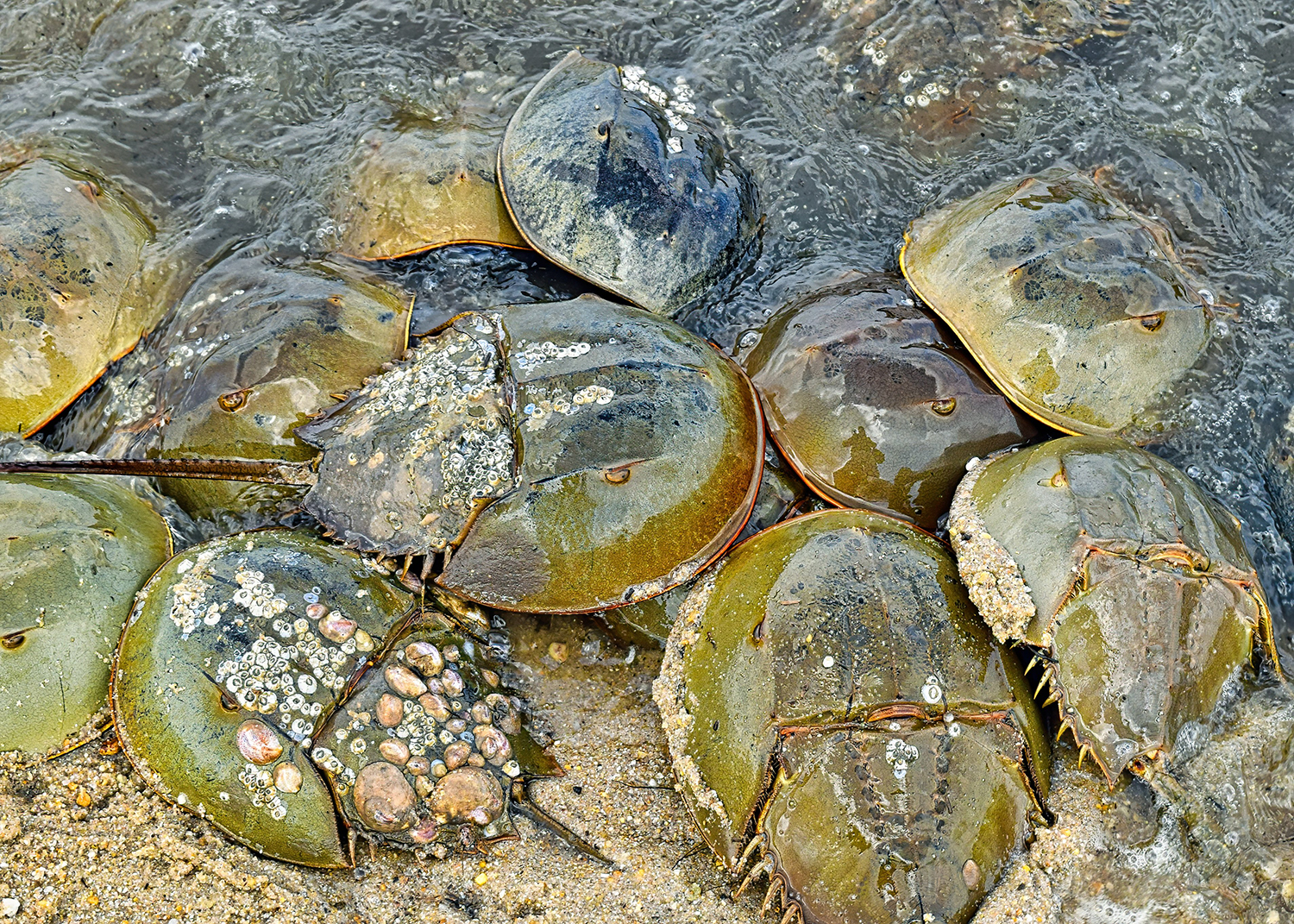
Like Jack Levin, Anthony Dellinger of Kepley Biosystems Inc. had never seen a horseshoe crab until 2018, when he began a Limulus research project, supported by a North Carolina Sea Grant minigrant.
He had worked with LAL as a student in biology labs and in other research posts, but he was unaware of its origin in horseshoe crabs. “I didn’t even know that the animal existed,” Dellinger says.
Eventually he learned about the organism — and saw an opportunity. He and his team could raise horseshoe crabs through aquaculture and bleed them in-house for LAL. That way, they could help curb wild collection. If they bled crabs at regular intervals, they could potentially increase exponentially the amount of LAL that can be produced per crab each year.
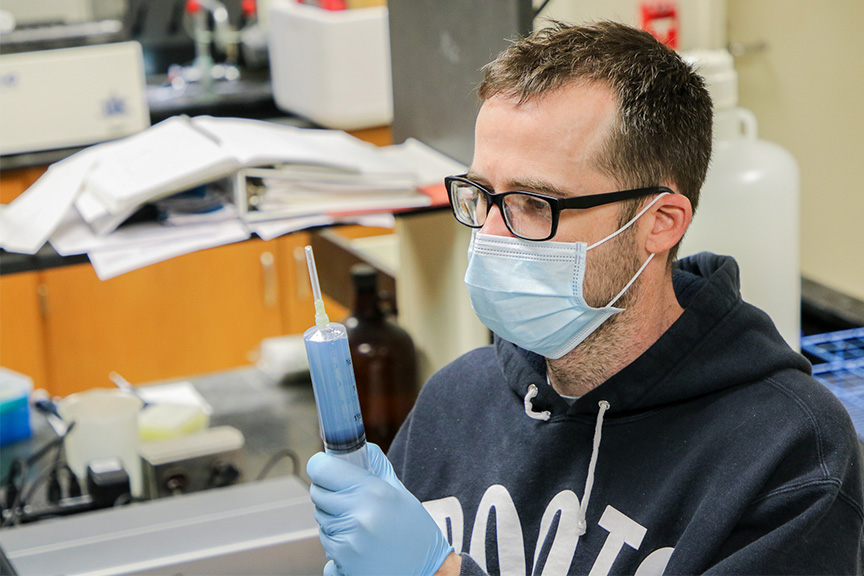
The N.C. Sea Grant minigrant enabled the Kepley team to acquire several horseshoe crabs, construct an aquaculture apparatus, and generate preliminary data.
“One role of our minigrant program is to stimulate innovation, and Kepley’s horseshoe crab aquaculture idea struck us as a unique concept worth supporting,” says John Fear, North Carolina Sea Grant’s deputy director.
Dellinger adds that the minigrant “allowed us to get to a serious stage.” Indeed, after their initial project, his team received funding from the National Science Foundation to continue their husbandry research.
Working with University of Georgia Marine Extension and Georgia Sea Grant, Dellinger and his collaborators constructed four outdoor pens from PVC pipe and crab trap wire in a pond located at the 4-H Tidelands Nature Center on Jekyll Island.
The team monitored 40 crabs over the course of several months. “This was something totally different than I’ve ever worked with,” says marine resource specialist Lisa Gentit, who assisted with the fieldwork.
For comparison, Dellinger’s team also investigated crabs raised indoors in a recirculating aquaculture system.
Their results indicated that the indoor system was superior to the outdoor pens. For one, 100% of the 24 indoor crabs survived. Meanwhile, seven of the crabs raised outside died, likely because water temperatures got too warm and dissolved oxygen got too low, according to Gentit.
Outdoor aquaculture also posed logistical challenges. “It was really difficult to find [the crabs] in the pens, because they will bury up into the mud and sand,” Gentit explains. “So, you had to basically dive under and feel around in the dirt, in the sediment, to find them.”
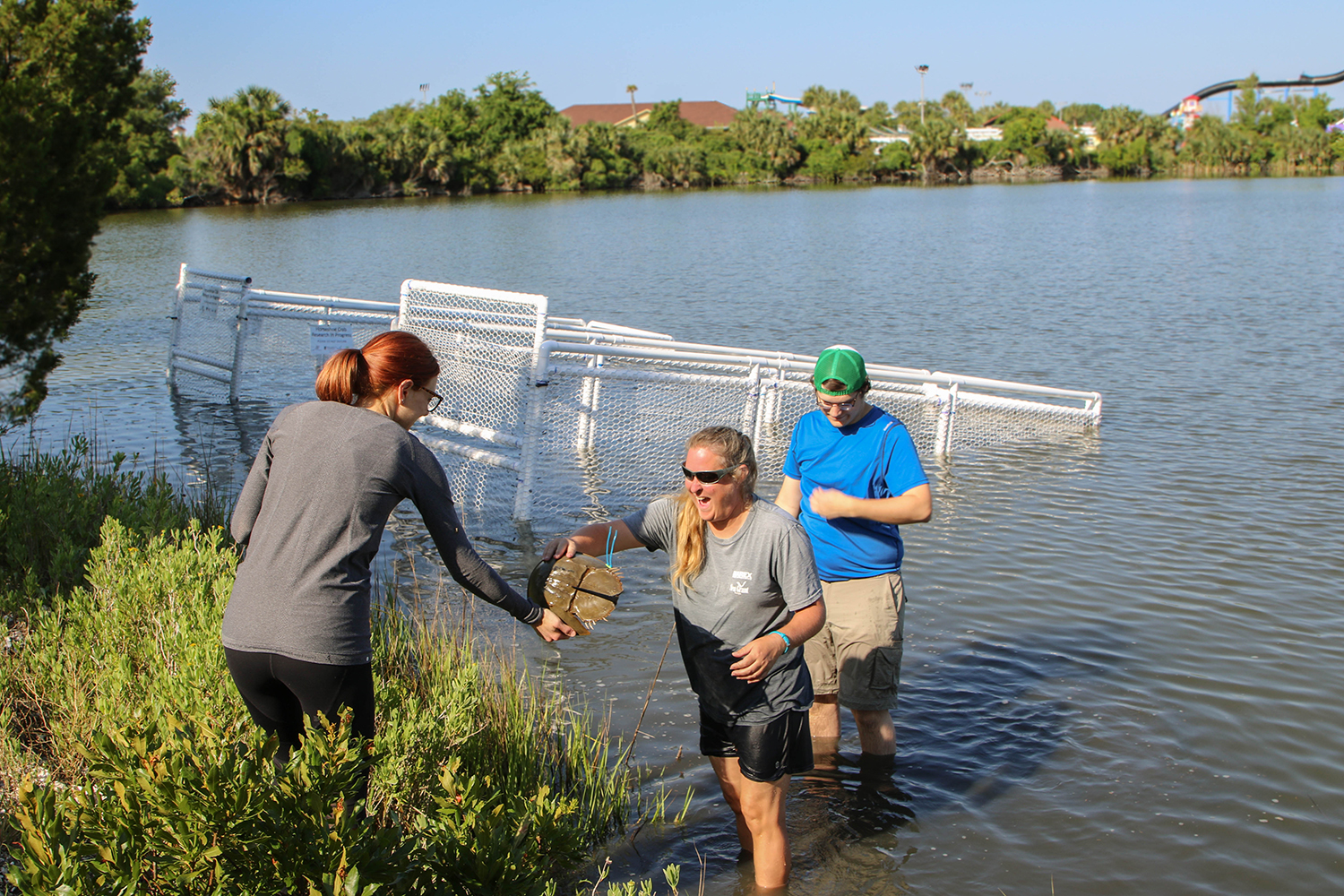
Dellinger maintains that outdoor aquaculture has advantages, but it “introduces uncontrollable variables, like weather and temp,” he says. In indoor systems, crabs can be closely monitored and their diets controlled.
As Gauvry of ERDG sees it, raising crabs and bleeding them all in the same facility could help preserve their well-being.
“Anytime that you take a wild animal out of its natural habitat, you’ve interjected stress,” says Gauvry, who serves with Dellinger on an IUCN work group focused on the horseshoe crab trade. “Anthony’s approach eliminates that. These animals become acclimated to the environment that they’re in,” at least theoretically, he says.
Dellinger’s team has also been developing a nutritional regimen that has so far proven to ensure horseshoe crab vitality and LAL quality. At this article’s writing, the journal Frontiers in Marine Science was reviewing a paper on that work.
Dellinger envisions ultimately building multiple horseshoe crab aquaculture facilities for LAL production. Growers could be trained to raise the animals, while traveling phleboto- mists could circulate around the facilities to bleed them on a rotating basis, he explains.
Achieving that goal would require substantial investment, Dellinger acknowledges. And it’s possible that, in the meantime, an alternative assay that already exists — one that negates the need for horseshoe crabs altogether — will become more widely adopted. That assay uses material called recombinant Factor C, or rFC, but its use in endotoxin testing is not standard in the U.S.
For his part, Dellinger says that demand for LAL “is likely going to increase” and thinks Kepley could satisfy that market. “We’ve always been of the opinion that if you could do it very thoughtfully and consciously and optimize the aquaculture, then there’s not necessarily a need to transition away from LAL, especially if you can use a fraction of the crabs,” he says. “You would still have this perfect end product, just in a more sustainable form.”
Access the PDF version of this article.
Supplemental content for grade 6-12 educators accompanies this article.

